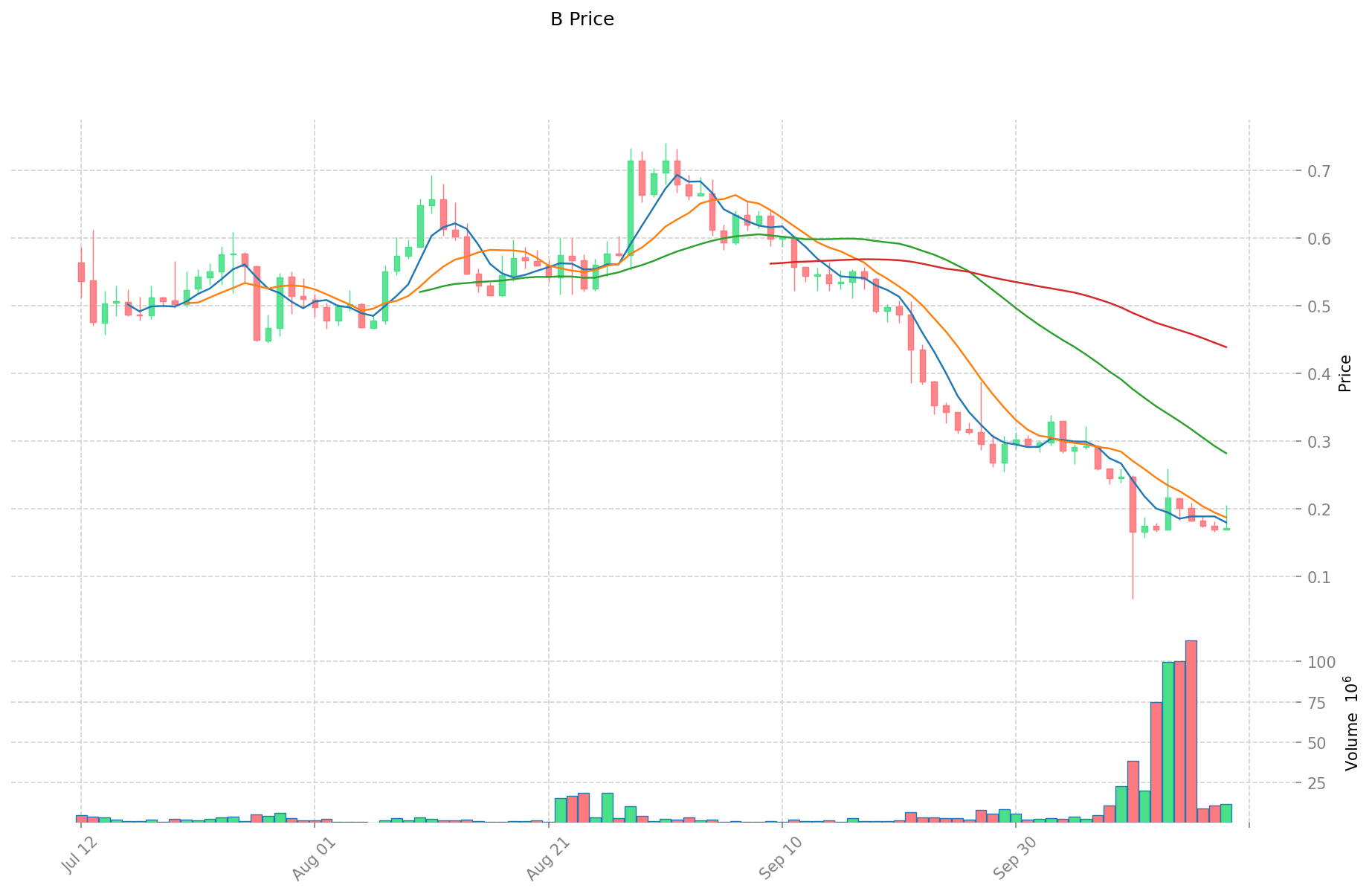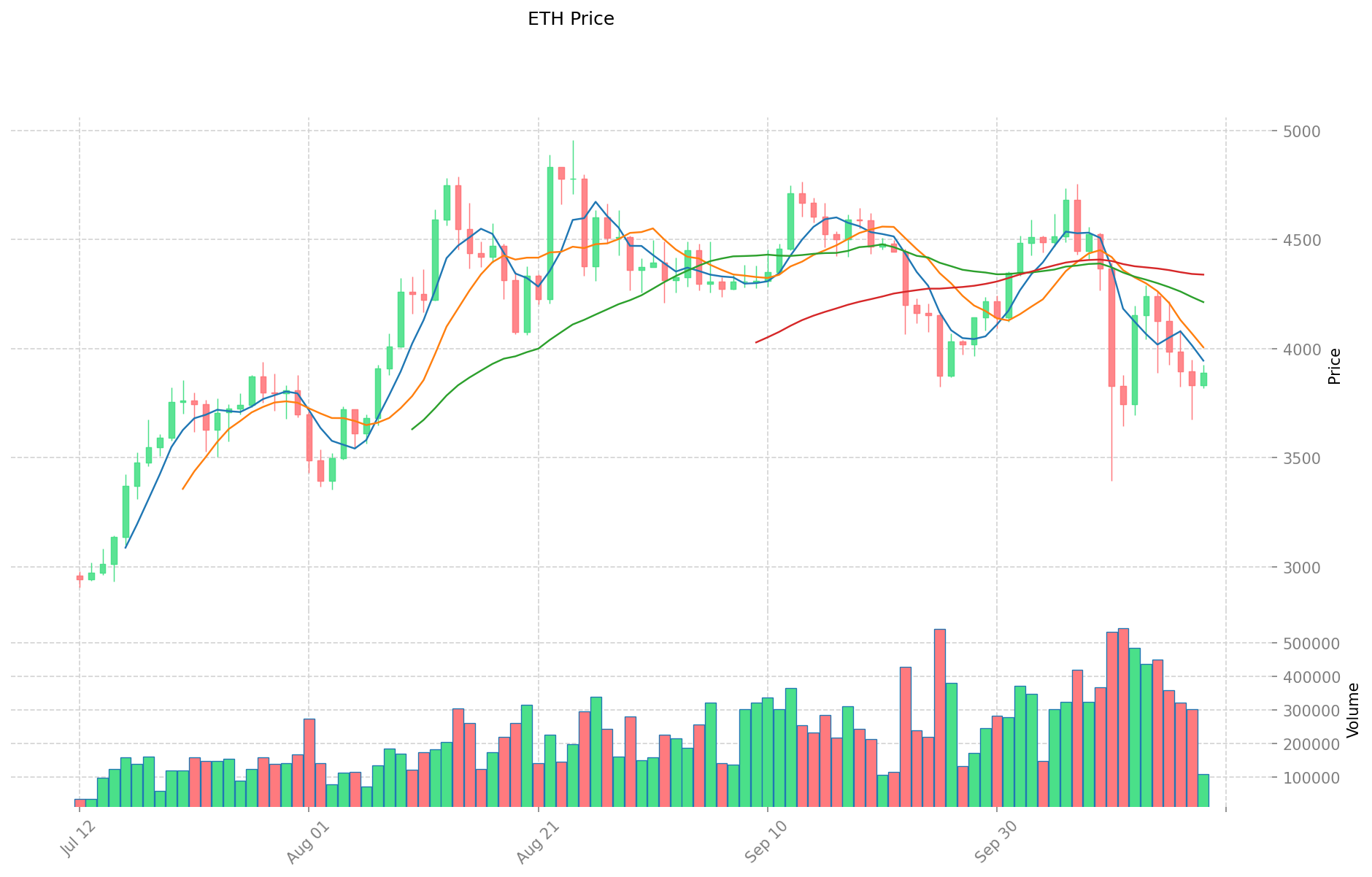B vs ETH: The Battle for Blockchain Supremacy in the Digital Age
Introduction: Investment Comparison of B vs ETH
In the cryptocurrency market, the comparison between BUILDon (B) and Ethereum (ETH) has always been a topic that investors can't ignore. The two not only have significant differences in market cap ranking, application scenarios, and price performance, but also represent different positions in crypto assets.
BUILDon (B): Launched in 2025, it has gained market recognition for its focus on building USD1 into a living, liquid, usable on-chain asset on BNB Smart Chain.
Ethereum (ETH): Since its inception in 2015, it has been hailed as the foundation for decentralized applications and smart contracts, and is one of the cryptocurrencies with the highest global trading volume and market capitalization.
This article will comprehensively analyze the investment value comparison between B and ETH, focusing on historical price trends, supply mechanisms, institutional adoption, technological ecosystems, and future predictions, and attempt to answer the question that concerns investors the most:
"Which is the better buy right now?"
I. Price History Comparison and Current Market Status
BUILDon (B) and Ethereum (ETH) Historical Price Trends
- 2025: BUILDon reached its all-time high of $0.7414 on August 31, 2025, and its all-time low of $0.0663 on October 10, 2025.
- 2025: Ethereum hit a new all-time high of $4,946.05 on August 25, 2025, significantly surpassing its previous record.
- Comparative analysis: In the recent market cycle, BUILDon experienced extreme volatility, dropping from its peak to near its all-time low within a short period. Meanwhile, Ethereum has shown more stability, maintaining a strong position above $3,800.
Current Market Situation (2025-10-19)
- BUILDon current price: $0.1718
- Ethereum current price: $3,885.25
- 24-hour trading volume: $2,102,748.18 (B) vs $420,331,968.08 (ETH)
- Market Sentiment Index (Fear & Greed Index): 23 (Extreme Fear)
Click to view real-time prices:
- View B current price Market Price
- View ETH current price Market Price


II. Core Factors Affecting Investment Value of BTC vs ETH
Supply Mechanisms Comparison (Tokenomics)
- Bitcoin: Fixed supply cap of 21 million coins with halving events approximately every four years, creating artificial scarcity
- Ethereum: Post-merge deflationary model with EIP-1559 burn mechanism where transaction fees are partially burned, reducing net issuance
- 📌 Historical pattern: Bitcoin's halving cycles have historically preceded bull markets, while Ethereum's shift to proof-of-stake and fee burning mechanism has created deflationary pressure during high network activity periods.
Institutional Adoption and Market Applications
- Institutional holdings: Bitcoin maintains stronger institutional presence through spot ETFs, corporate treasury reserves, and traditional finance integration
- Enterprise adoption: Bitcoin serves as digital gold and settlement layer, while Ethereum offers broader utility for DeFi applications, tokenization of assets, and smart contract infrastructure
- National policies: El Salvador and CAR have adopted Bitcoin as legal tender, while numerous countries are exploring CBDC infrastructure using Ethereum-based technology
Technical Development and Ecosystem Building
- Bitcoin technical upgrades: Lightning Network scaling solution, Taproot privacy enhancement, and Ordinals/BRC-20 tokens expanding use cases
- Ethereum technical development: Shift to proof-of-stake, implementation of sharding, and layer 2 solutions driving scalability improvements
- Ecosystem comparison: Ethereum leads in DeFi TVL ($41B+), NFT market share, and developer activity, while Bitcoin maintains dominance in store of value and payment applications with growing Lightning Network adoption
Macroeconomic Factors and Market Cycles
- Performance during inflation: Bitcoin has demonstrated stronger correlation with inflation hedging narratives and gold-like properties
- Macroeconomic monetary policy: Both assets show sensitivity to interest rates and USD strength, with Bitcoin typically exhibiting higher volatility in response
- Geopolitical factors: Bitcoin offers greater censorship resistance for cross-border transactions in unstable regions, while Ethereum provides infrastructure for decentralized financial services globally
III. 2025-2030 Price Prediction: B vs ETH
Short-term Prediction (2025)
- B: Conservative $0.16416 - $0.171 | Optimistic $0.171 - $0.25479
- ETH: Conservative $3730.3776 - $3885.81 | Optimistic $3885.81 - $5478.9921
Mid-term Prediction (2027)
- B may enter a growth phase, with expected prices ranging from $0.163290465 to $0.336629574
- ETH may enter a steady growth phase, with expected prices ranging from $2775.72734244 to $5892.33348132
- Key drivers: Institutional capital inflow, ETF, ecosystem development
Long-term Prediction (2030)
- B: Base scenario $0.269100392088966 - $0.368630674094475 | Optimistic scenario $0.368630674094475 - $0.431297888690535
- ETH: Base scenario $4738.59739564680924 - $6581.3852717316795 | Optimistic scenario $6581.3852717316795 - $7502.77920977411463
Disclaimer
B:
| 年份 | 预测最高价 | 预测平均价格 | 预测最低价 | 涨跌幅 |
|---|---|---|---|---|
| 2025 | 0.25479 | 0.171 | 0.16416 | 0 |
| 2026 | 0.2895372 | 0.212895 | 0.12986595 | 23 |
| 2027 | 0.336629574 | 0.2512161 | 0.163290465 | 46 |
| 2028 | 0.35564663277 | 0.293922837 | 0.26746978167 | 71 |
| 2029 | 0.41247661330395 | 0.324784734885 | 0.24358855116375 | 89 |
| 2030 | 0.431297888690535 | 0.368630674094475 | 0.269100392088966 | 114 |
ETH:
| 年份 | 预测最高价 | 预测平均价格 | 预测最低价 | 涨跌幅 |
|---|---|---|---|---|
| 2025 | 5478.9921 | 3885.81 | 3730.3776 | 0 |
| 2026 | 5056.993134 | 4682.40105 | 2528.496567 | 20 |
| 2027 | 5892.33348132 | 4869.697092 | 2775.72734244 | 25 |
| 2028 | 7587.2315541906 | 5381.01528666 | 4358.6223821946 | 38 |
| 2029 | 6678.647123038059 | 6484.1234204253 | 4603.727628501963 | 66 |
| 2030 | 7502.77920977411463 | 6581.3852717316795 | 4738.59739564680924 | 69 |
IV. Investment Strategy Comparison: BUILDon (B) vs Ethereum (ETH)
Long-term vs Short-term Investment Strategies
- BUILDon (B): Suitable for investors focused on emerging ecosystems and potential high-risk, high-reward opportunities
- Ethereum (ETH): Suitable for investors seeking established networks with proven utility and long-term growth potential
Risk Management and Asset Allocation
- Conservative investors: B: 5% vs ETH: 95%
- Aggressive investors: B: 30% vs ETH: 70%
- Hedging tools: Stablecoin allocation, options, cross-currency portfolios
V. Potential Risk Comparison
Market Risk
- BUILDon (B): High volatility, low liquidity, and potential for significant price swings
- Ethereum (ETH): Market sentiment shifts, competition from other smart contract platforms
Technical Risk
- BUILDon (B): Scalability, network stability, and ecosystem development challenges
- Ethereum (ETH): Successful implementation of scaling solutions, potential bugs in smart contracts
Regulatory Risk
- Global regulatory policies may have different impacts on both assets, with ETH potentially facing more scrutiny due to its wider adoption and use in DeFi
VI. Conclusion: Which Is the Better Buy?
📌 Investment Value Summary:
- BUILDon (B) advantages: Potential for high growth, focus on specific use case (USD1 as on-chain asset)
- Ethereum (ETH) advantages: Established ecosystem, proven track record, ongoing technical improvements
✅ Investment Advice:
- New investors: Consider allocating a larger portion to ETH for stability, with a small exposure to B for potential growth
- Experienced investors: Balanced approach with a tilt towards ETH, but increased allocation to B based on risk tolerance
- Institutional investors: Focus on ETH for its liquidity and established market presence, with potential small allocations to B for diversification
⚠️ Risk Warning: The cryptocurrency market is highly volatile, and this article does not constitute investment advice. None
VII. FAQ
Q1: What are the key differences between BUILDon (B) and Ethereum (ETH)? A: BUILDon (B) is a newer cryptocurrency focused on building USD1 as an on-chain asset on BNB Smart Chain, launched in 2025. Ethereum (ETH) is an established platform for decentralized applications and smart contracts, launched in 2015. ETH has a larger market cap, higher trading volume, and a more developed ecosystem.
Q2: Which cryptocurrency has shown better price performance recently? A: Ethereum (ETH) has shown more stability in recent market cycles, maintaining a strong position above $3,800. BUILDon (B) experienced extreme volatility, dropping from its peak to near its all-time low within a short period in 2025.
Q3: How do the supply mechanisms of B and ETH differ? A: BUILDon's supply mechanism is not specified in the given information. Ethereum has a post-merge deflationary model with the EIP-1559 burn mechanism, where transaction fees are partially burned, reducing net issuance.
Q4: What are the price predictions for B and ETH by 2030? A: For B, the base scenario predicts $0.269100392088966 - $0.368630674094475, with an optimistic scenario of $0.368630674094475 - $0.431297888690535. For ETH, the base scenario predicts $4738.59739564680924 - $6581.3852717316795, with an optimistic scenario of $6581.3852717316795 - $7502.77920977411463.
Q5: How should investors allocate their portfolio between B and ETH? A: Conservative investors might consider allocating 5% to B and 95% to ETH, while aggressive investors might allocate 30% to B and 70% to ETH. The exact allocation depends on individual risk tolerance and investment goals.
Q6: What are the main risks associated with investing in B and ETH? A: For B, risks include high volatility, low liquidity, and potential for significant price swings. For ETH, risks include market sentiment shifts, competition from other smart contract platforms, and potential bugs in smart contracts. Both face regulatory risks, with ETH potentially facing more scrutiny due to its wider adoption.
Q7: Which cryptocurrency is considered a better buy for different types of investors? A: New investors might consider allocating more to ETH for stability, with small exposure to B for growth potential. Experienced investors could take a balanced approach, tilting towards ETH but with increased B allocation based on risk tolerance. Institutional investors might focus on ETH for liquidity and market presence, with potential small allocations to B for diversification.
Share
Content